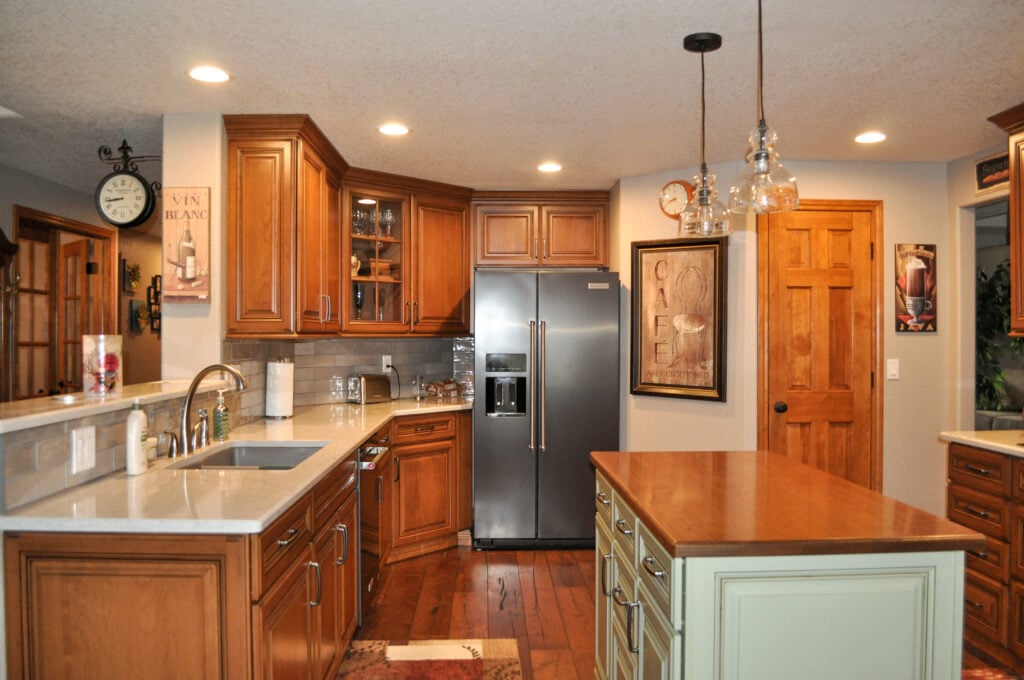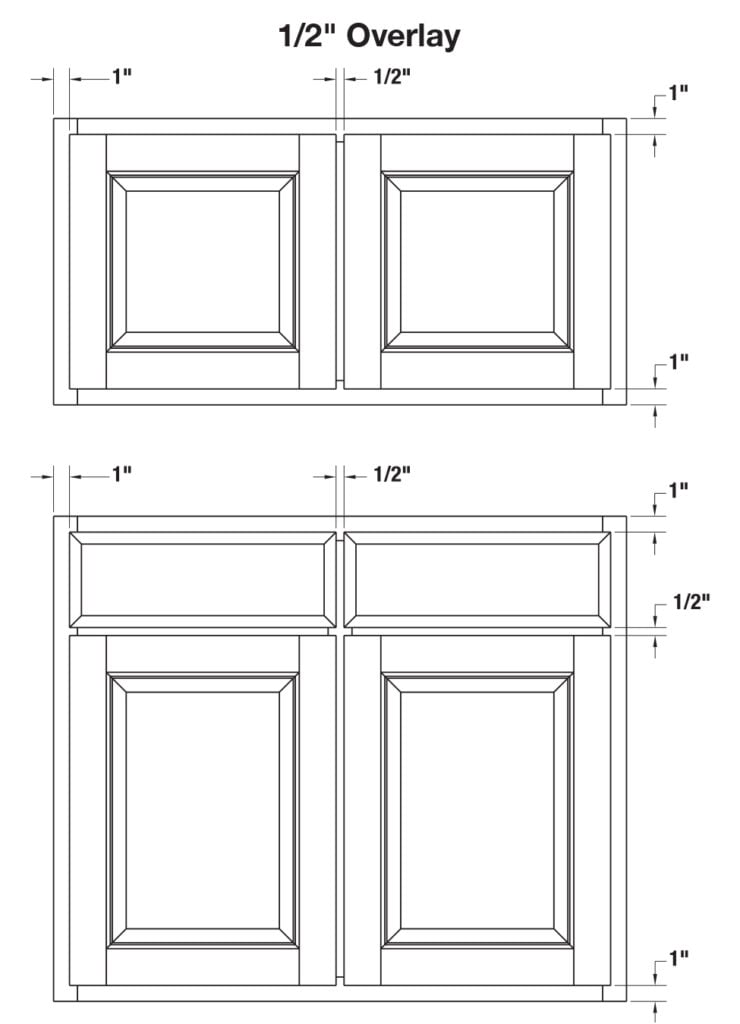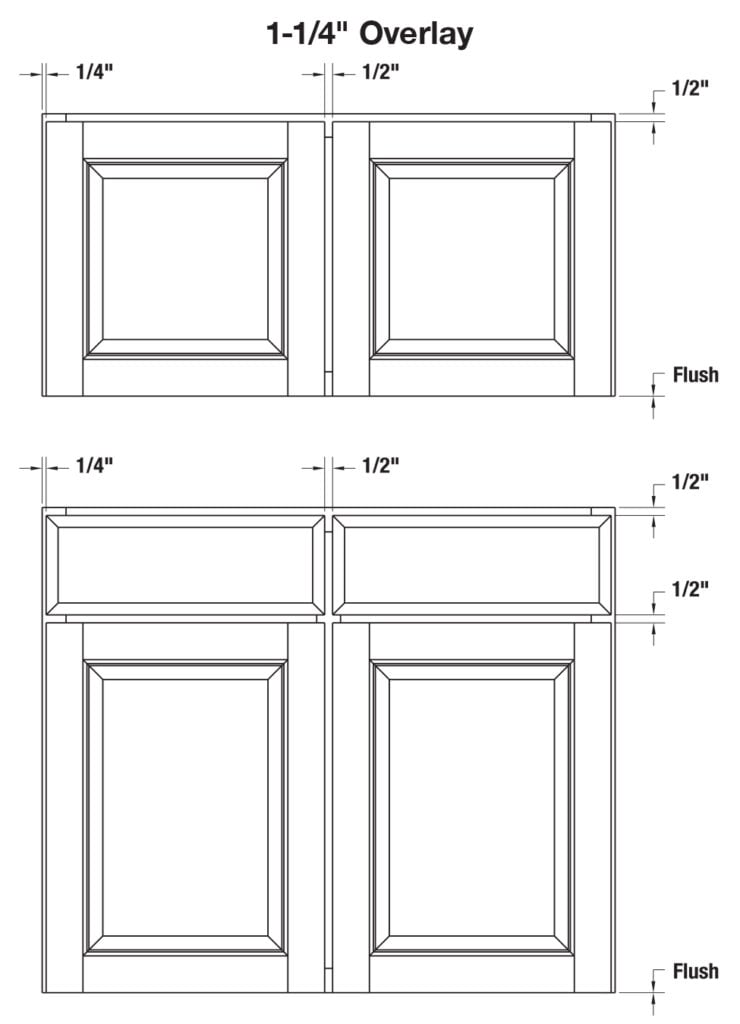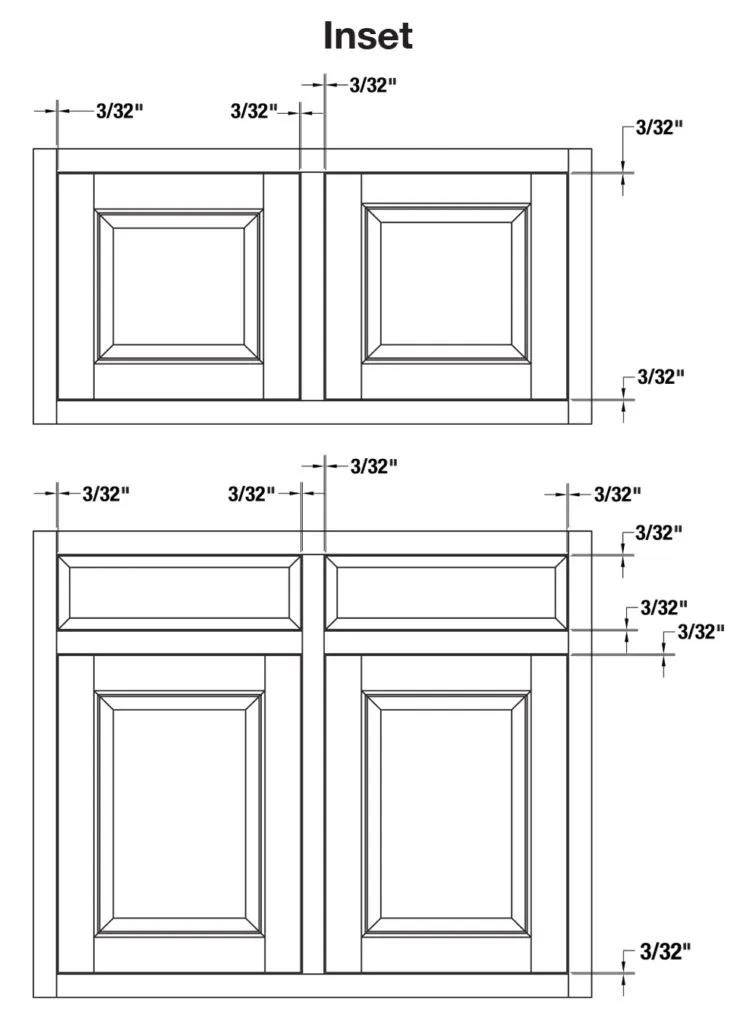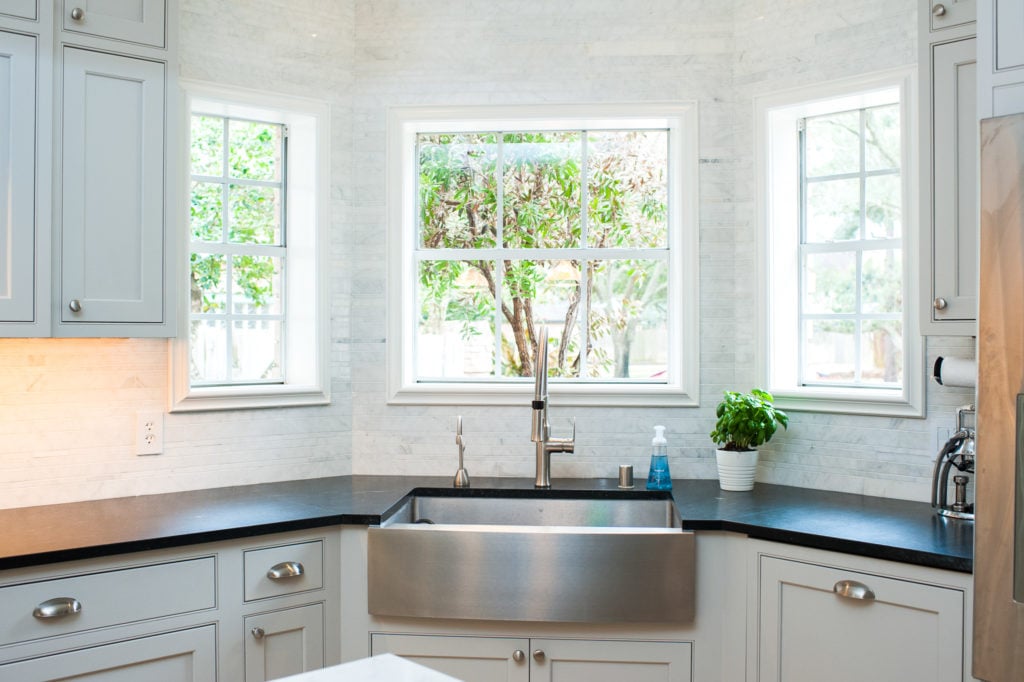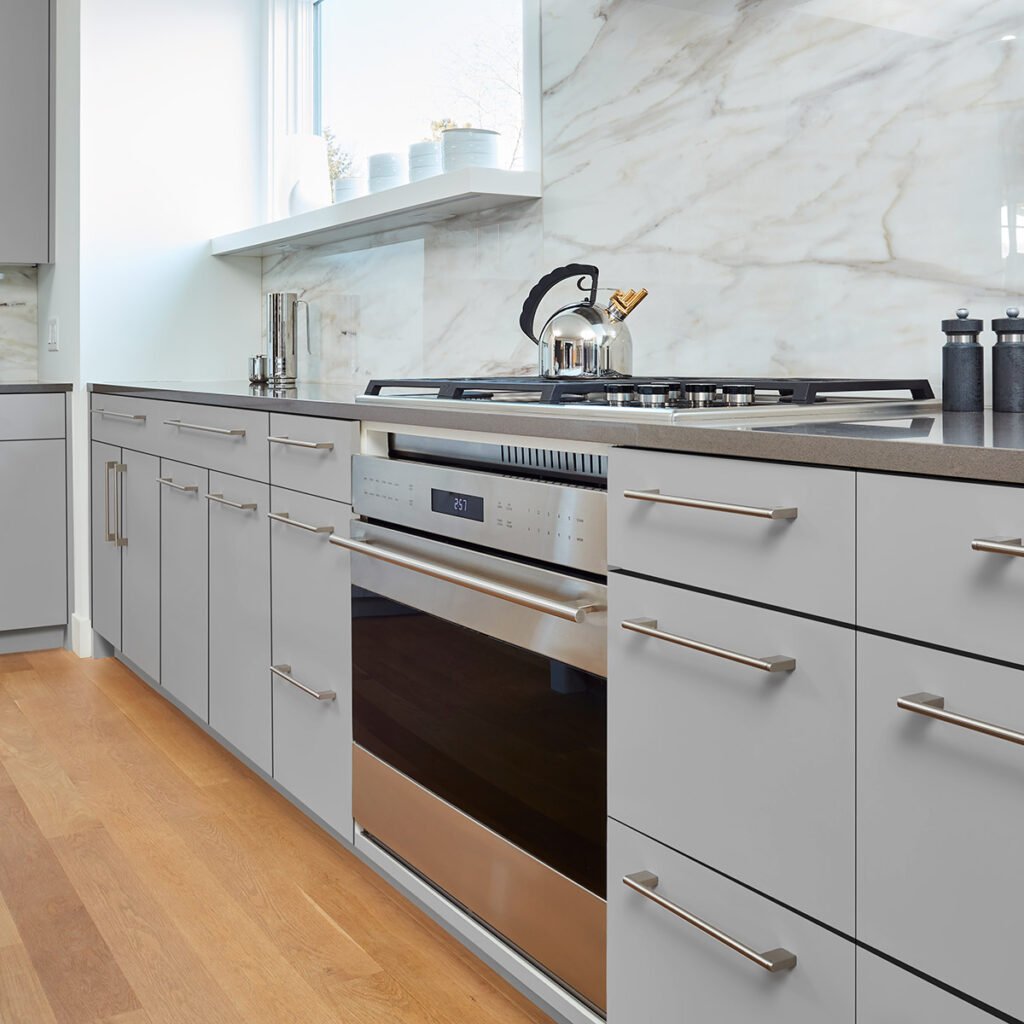Framed vs. Frameless Cabinets
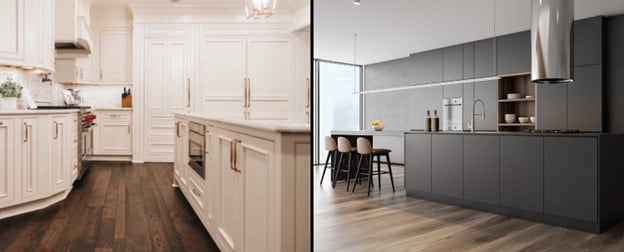
Inset, Overlay, and Frameless: the Differences Explained
Inset… Overlay… Frameless… These are terms that are often thrown around in the lump of indiscernible cabinet jargon the moment you stick your head in the kitchen design door. You want cabinets, and you want them now! But what are these different types? What’s the difference between them? And why does it matter?
For starters, let’s take a look at the basic designs.
Both the terms “inset” and “overlay” refer to types of framed cabinetry with very different looks. In general, a framed construction employs a frame about 1.5 in. wide on the face of the cabinet, an additional wooden support that can be seen all the way around the opening on the front of the cabinet box. On framed cabinetry, the door hinges to this face frame and the frame provides extra support plus aesthetic value.
Overlay refers to cabinets on which the cabinet door partially or fully sits on top of the frame, covering the opening of the box from the outside. On partial overlay cabinets, the door covers about .5 in. of the frame on all sides, which leaves an inch of the frame exposed on all sides including the bottom. With full overlay cabinets, the door is sized to cover 1¼ in. of the frame, leaving ¼ of an inch accordingly along the sides, ½ of an inch exposed along the top. On full overlay, the door is set flush against the bottom of the face frame. Many people who are drawn to full overlay would probably love the look of frameless cabinetry, as it achieves a similar look and has honed the functionality aspect as well.
In inset cabinetry, the door is sized precisely to the opening of the face frame, leaving the entire piece visible.
Unlike all of these previous options, the frameless cabinet, by name, is built without a face frame. In contrast to overlay, the doors hinge directly to the interior wall of the cabinet box. The door covers all but 1/8 in. of the cabinet box. When opening the cabinet, there is no 1 1/2 in. frame on all sides hindering one’s use of the box, coining the alternate term to frameless, which is “full-access”. These cabinets are also known as Eurostyle for the widespread popularity of their mod-style in Europe.
If you’re a more visual learner, it might be helpful to peruse Cabinet Joint’s selection of videos such as this one demonstrating the difference between these cabinet types. (Note that since this video was created we do now offer a frameless line of cabinets called Access by Cabinet Joint.)
That’s all well and good, but are some of these cabinets more challenging to install than others?
In general, frameless cabinets are easier to install than the other types of cabinets because there are fewer steps to putting them together, and fewer pieces needed for the installation. However, even between inset and overlay cabinetry there are some differences in how involved they are to put together. For instance, for inset cabinetry, it takes a bit more attention to detail to line up the door within the face frame just so. And, though frameless cabinets have fewer moving pieces, so to speak, they can be more particular when it comes to angles. If the wall is imperfectly straight, the cut of wood could start to sag over time under an uneven force. No worries! That’s what the leg levelers are for.
Are there any big price differences I should know about?
Before any customizations, inset cabinetry tends to be a touch pricier than overlay when it comes to the differences within the framed cabinetry family. This is because the doors are crafted to fit flush and even within the face frame which, just as aforementioned in regards to their installation, requires a bit more attention to detail and are priced accordingly. When purchased through a cabinet shop that also installs them, there is usually a 25-30% upcharge on inset cabinetry because of the additional attention they require. However, as the Wall Street Journal recently noted about inset cabinetry’s growing popularity, Cabinet Joint is a good place to turn as our quality and pricing are hard to beat.
High-quality frameless cabinetry lasts a long time and has a structure that is similarly durable to framed cabinetry. Instead of employing a frame for additional support, frameless cabinets tend to be made from durable particleboard and a strong but light laminate over top. The recent developments in lamination have led to such inventions as thermally fused laminates, which are much harder to scratch and pierce than hardwood. The cost of Cabinet Joint’s frameless cabinetry is comparable to that of their framed cabinetry as they are alike also in their quality, sturdiness, and good looks.
Now that we’ve covered what is technically different about these cabinets, what makes them functionally different?
One consideration to keep in mind in regards to a framed construction is that the frame itself takes up space. Frameless cabinets, in contrast, have no center stile preventing easy access to the whole cabinet space. In fact, frameless cabinets are also known as “full-access” cabinets because they are most space efficient when it comes to maximizing your storage capacity. On cabinet boxes the same width across, the absence of a frame can add an inch or more in space in comparison to framed cabinets, which adds up quickly.
Another difference between these cabinet types is that cabinet boxes in a framed construction have some additional stability added by the face frame. Because of this greater stability, there is also a minimized chance of racking, which is when cabinet doors and drawers pull out of alignment. This is not so much of a concern for any finely crafted cabinet, like the ones you will find at Cabinet Joint, but it still can occur when they are hastily pulled in a particular way.
Now, which one looks best?
Depending on your specific tastes, there are ways to customize each type of cabinet in a way you will find pleasing. The traditional, American-style framed cabinets can add a sense of heritage to your home, or keep up with the legacy your kitchen has already set. Inset cabinets have a classic farmhouse look to them, while overlay cabinets have a more modernized presence. Frameless cabinets are the most modern at all, with their incredibly seamless look and efficiency of space that’s right on trend. Despite the way these constructions tend to look, Cabinet Joint clients have proven the multitude of ways cabinetry can be fitted to your tastes through our customization program. Make sure to follow @cabinetjoint on Instagram for fresh customer photos, daily inspiration, and check back to our blog for the latest news in cabinetry!

